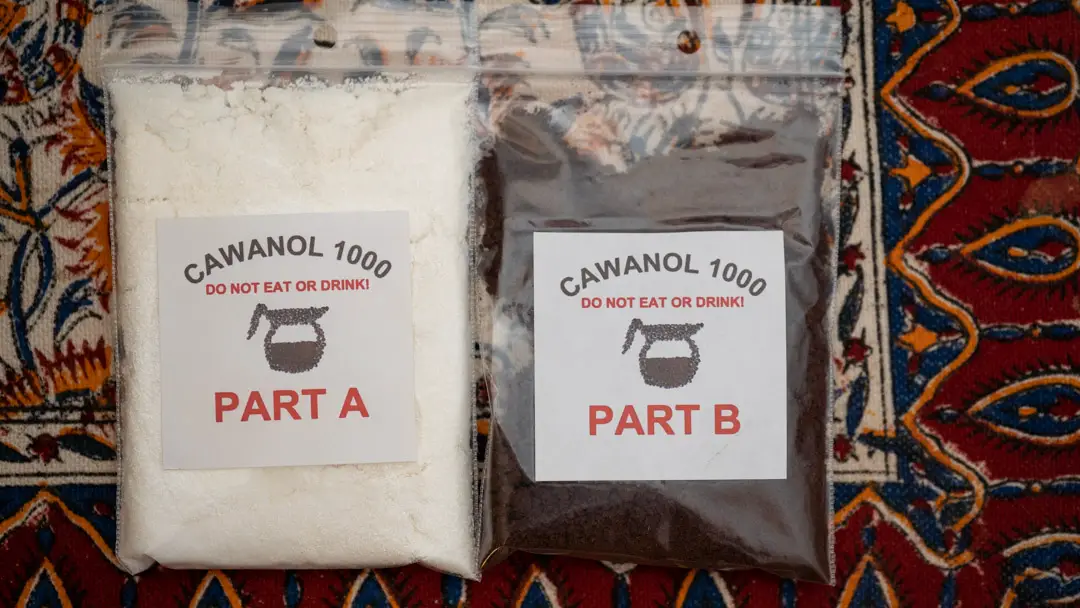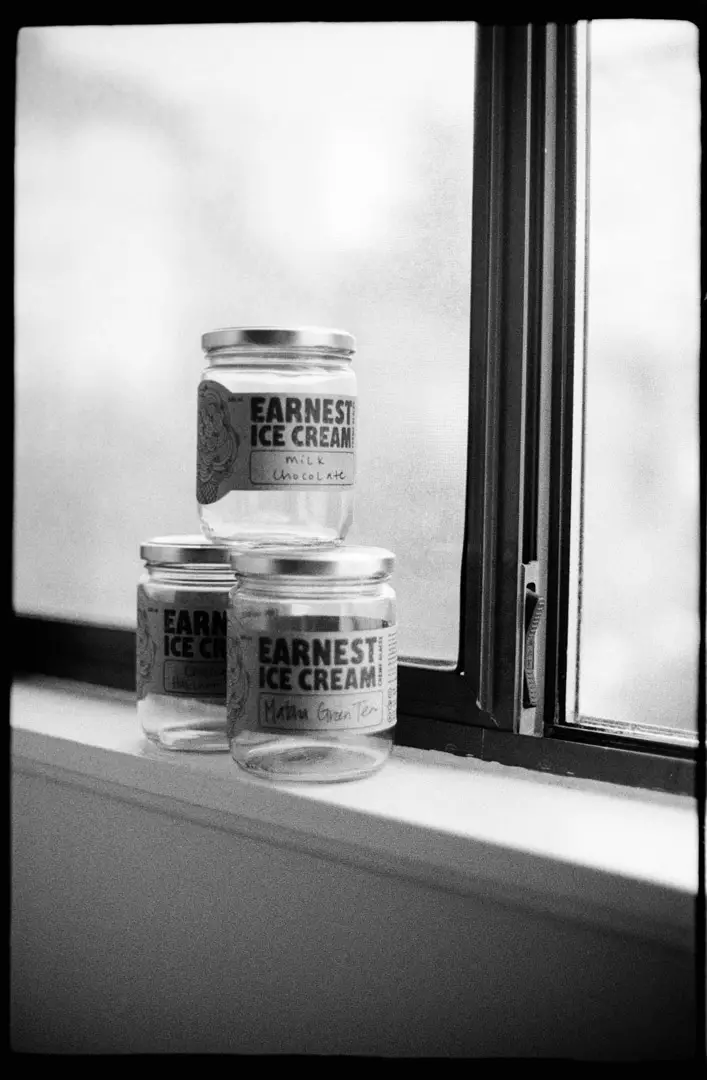Even by modern standards, film photography is a marvel of human ingenuity and engineering. It took multiple generations of dedicated science to get where we are today. But if we don’t preserve it, much of that information could be lost forever. And that’s what we’re here for today: to learn how exactly caffenol, a product made of ingredients you already have at home, can develop black and white film.
How does caffenol work?
Coffee contains the phenol caffeic acid, which — in a pH 11 solution — reacts with the developable silver halide crystals, leaving metallic silver back on the film. When Vitamin C is added to the caffenol solution, it recharges the caffeic acid, allowing it to develop film faster.
This is essentially how the developer works. All film developers are made from phenols, which are naturally occurring compounds found in many plants, like basil, potatoes, brussel sprouts, and broccoli. However, most commercial developers use phenols like hydroquinone, metol, and diemezone, which are common oil refining byproducts.
While the Vitamin C is not essential for developing film, it does dramatically decrease the amount of time needed to develop a single roll. Vitamin C also tends to produce sharper negatives.
Does caffenol produce bad results?
One of the biggest myths that exists in our time is that home-made products aren’t as robust as commercially-made products. And in many cases, it just isn’t true.
Caffenol with Vitamin C produces sharp, dense negatives with high contrast. Negatives developed with caffenol do tend to lose detail in the shadows when compared to D-76, DD-X, or HC-110. But overall, caffenol is a high-quality developer that is worth trying out for anyone who wants to make their film developing more environmentally-friendly, or when teaching kids how to shoot and develop film.
The downside of caffenol is that it is expensive. Even though the raw ingredients can be found on your shelves at home, the ingredients are needed in such high-quantities that the costs will quickly add up.
For example, a typical caffenol recipe requires 45 grams of instant coffee for 1L solution, which is half the average container on your grocery store shelf. For Vitamin C, you’ll need 20 grams, but there’s only 0.5 grams per tablet, meaning you’ll need 40 of them for this recipe alone. In total, the cost quickly rises $10+ for up to 4 rolls of film.
Once cheaper way is to purchase an industrial-made caffenol developer, like Cawanol Professional from Caffenol Labs in Ontario, Canada.

What is Caffenol made from?
Most caffenol recipes include just four ingredients:
Water, instant coffee, Vitamin C (usually in the form of ascorbate powder) and washing soda (or sodium carbonate).
Most recipes ask for instant coffee because it is a more reliable source of caffeic acid than brewed coffee. Instant coffee will always contain the same ingredients, where coffee beans may differ in their composition at different times of year, or when sourced from different countries. As well, the instant coffee just makes the mixing process easier overall.
Vitamin C is usually sourced from ascorbate powder, which can be found at almost any health food store or pharmacy. In a pinch, Vitamin C tablets can also be used, however, these tablets only contain a small amount of ascorbic acid, and can take a long time to dissolve. If using tablets instead of the powder, be sure to crush them and run the solution through a coffee filter to remove the undissolvable flotsam and jetsam. Find a reliable Vitamin C powder on Amazon here.
Washing soda (sodium carbonate) is used to increase the pH of the film developer. Phenols will not usually develop film in an acidic environment, instead needing a high pH of around 11-12 to function. There are some acid-based film developers, but they are not the norm. Sodium carbonate, or washing soda, is normally used for washing clothes and cleaning up warehouse spills. Find it on Amazon here.
Why do I need washing soda in caffenol?
Washing soda is integral to caffenol. Unfortunately, this developer will not work without it.
Washing soda brings up the pH of the solution to 11 or 12, which is the ideal range needed for film development to occur. Even though the other developing ingredients are acidic, the basic solution changes their formula and allows them to react with the developable grains in solution.
Almost all film developers are basic for this reason. That’s why an acid stop bath works to arrest development — it instantly brings the pH down to a level where the developer can no longer function. Stop baths also have the benefit of helping to protect the longevity of the acidic fixer (although, they are not always necessary).
What does Vitamin C do?
Vitamin C plays an important role in caffenol-based developers. It’s not strictly necessary, but adding Vitamin C will help to decrease the time it takes to develop a roll of film and to produce a sharper image with less base fog.
Vitamin C on its own is technically a film developer, but it does so painfully slow. It serves its best function when added alongside a normal phenol, like caffeic acid, or phenidone (another ultra-low eco-impact developer). When added to a solution with another developer, the Vitamin C is known as a superadditive, which helps to support the other developer by recharging their reducing properties.
Vitamin C can also work as a preservative in the solution, allowing the film developer to stay fresh without the use of sulfites. That, and it’s lack of an environmental impact make it a prime developing agent that is becoming more common in newly-produced developer recipes.
Which other film developers use Vitamin C?
There are a number of developers that use Vitamin C in their formulas.
The most well-known, commercially produced Vitamin-C based developer is Xtol by Kodak. This was the last film developer that they will likely ever make, and it’s one of the best that’s ever been produced.
However, the company has been having some serious reliability issues since the sale of Kodak Alaris, which produces the chemicals. Reformulations and new packaging materials have seen the chemicals die before ever being opened.
So that leaves room for competitors to jump in and make similar products with more reliable packaging.
One of those competitors is Eco Pro LegacyPro Ascorbate film developer, which is an exact XTol clone. The Legacy Pro developer uses the same development times and everything, and also only comes in a 5L kit (which can develop 10-20 medium format rolls, or 20-40 35mm rolls).
But one of the latest, and most interesting competitors to Xtol using non-toxic phenidone and Vitamin C is Flic Film’s Black, White, & Green developer. Black, White, and Green comes in a viscous liquid format similar to the old HC-110 formula (RIP) that is unlikely to ever expire. That means it’s easier to use, and is also one of, if not the most environmentally-friendly commercial developer.
Where can I find caffenol recipes?
The best place where I’ve found caffenol recipes is caffenol.org. This website is quick to load, and has a bunch of simple recipes available with the steps laid out beautifully. I’ve used their Delta recipe in the past with great success.
Caffenol is a lot of fun to try out, and I recommend it for anyone who wants to get serious about film photography. There’s no better way to learn about this craft than by doing some basic chemistry at home.
Have you experimented with caffenol before? Let me know what you thought down in the comments below!








